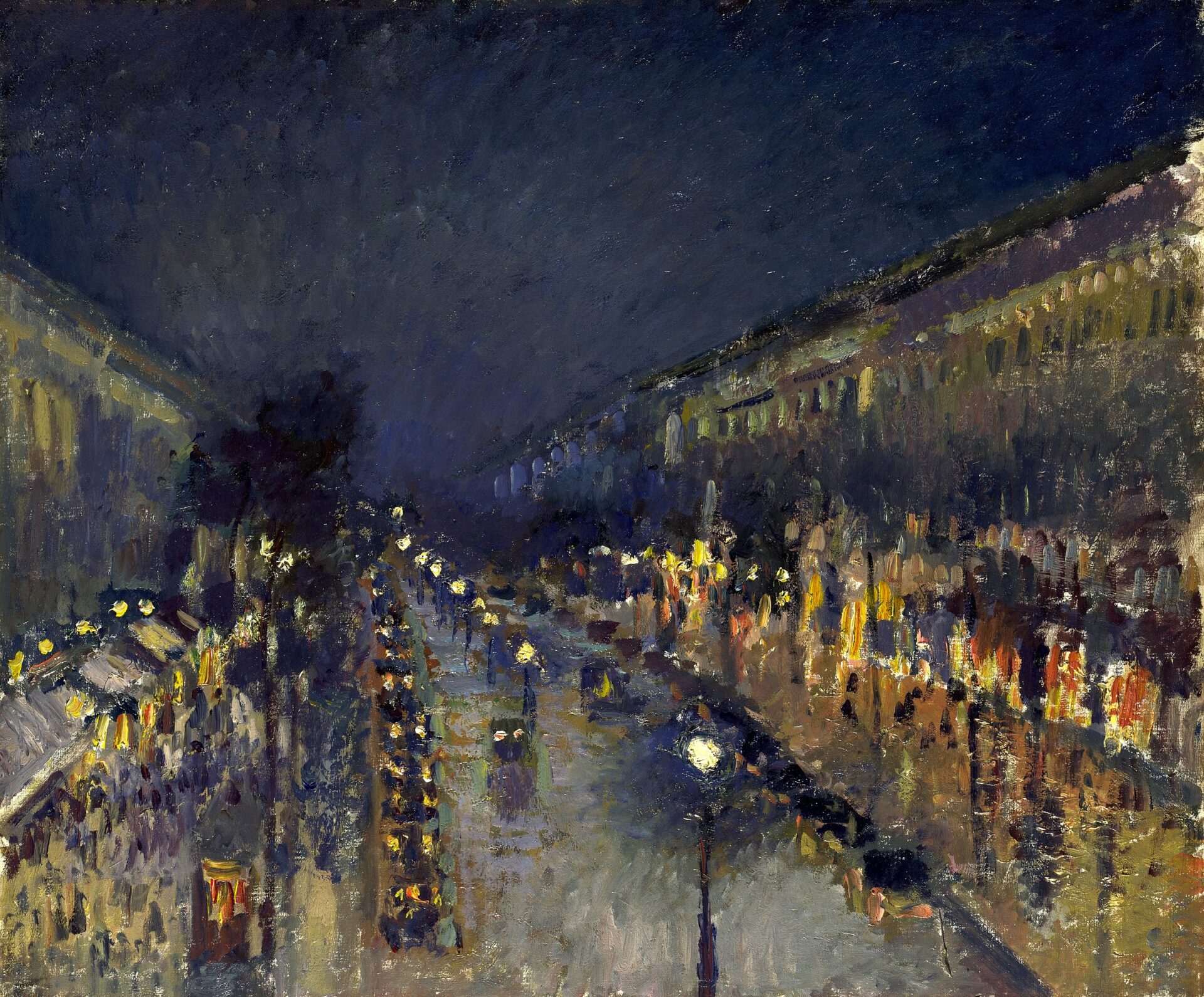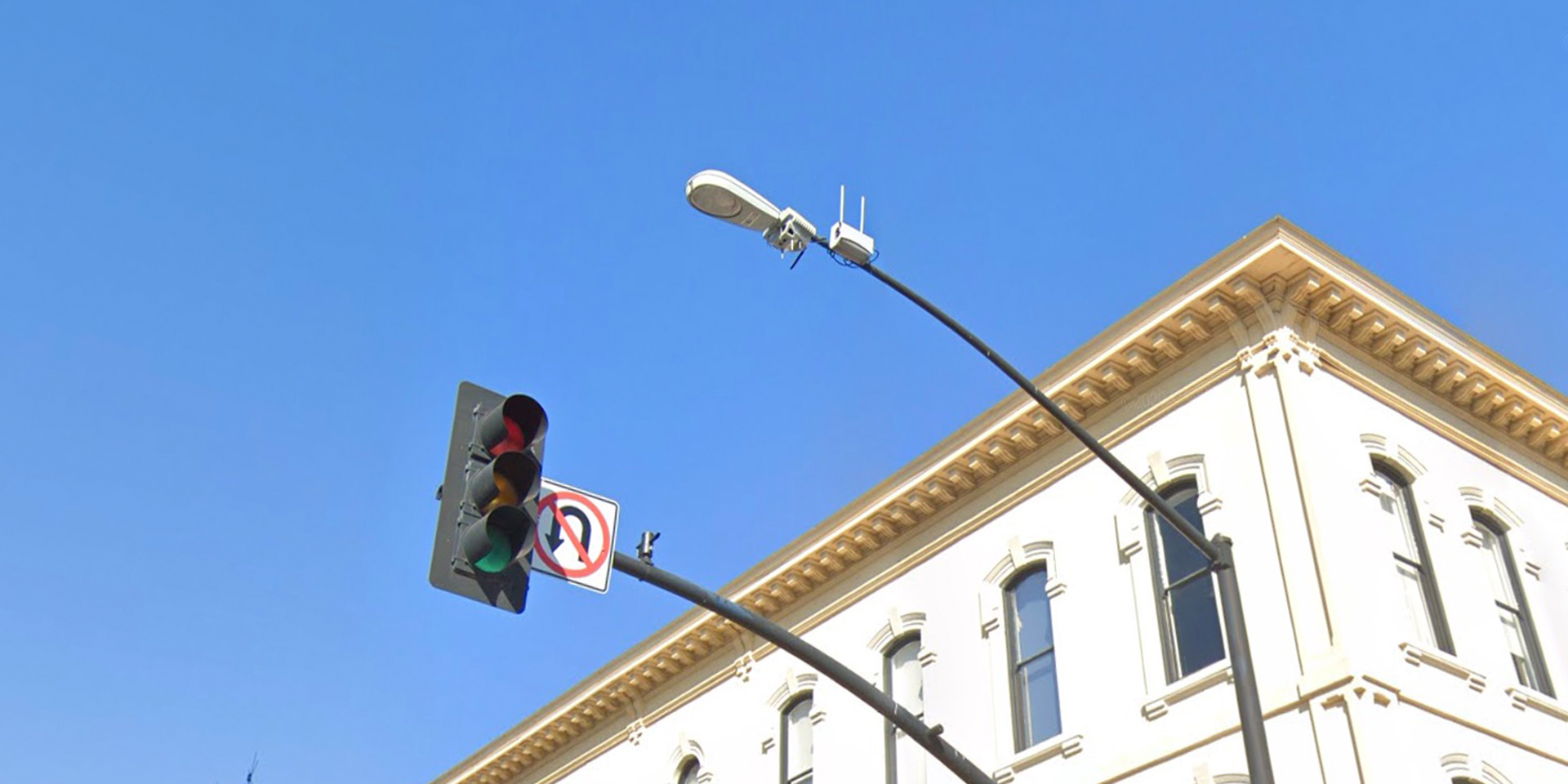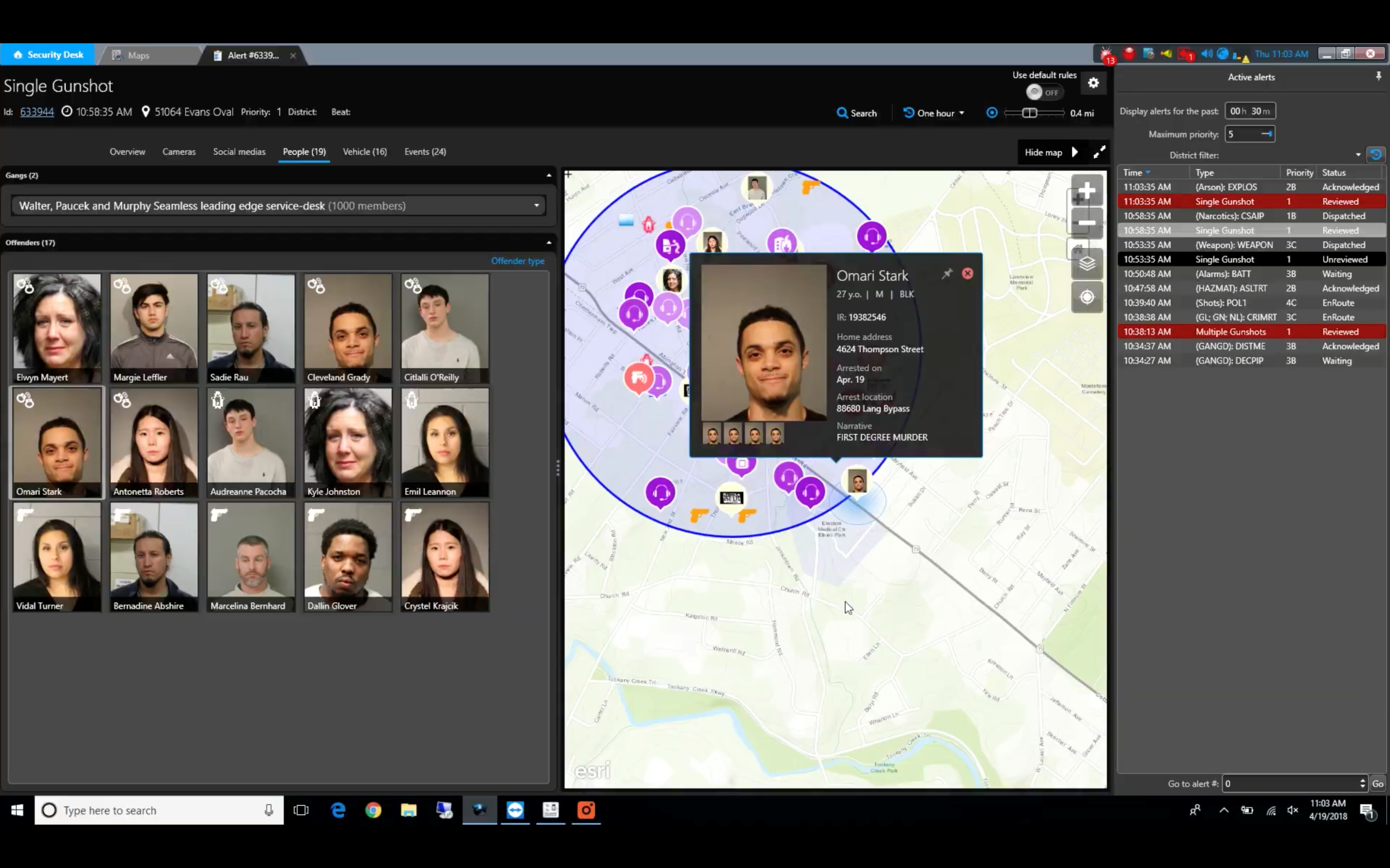“This is not a surveillance system—nobody is watching it 24 hours a day,” said Erik Caldwell, director of economic development in San Diego, in an interview where he was asked if the wide deployment of “smart” streetlights had turned San Diego into a surveillance city. Innocuous at first glance, this statement demonstrates the pernicious impact of artificial intelligence on new “smart” streetlight systems. As Caldwell suggests, a central human vision is important for the streetlight to function as a surveillance instrument. However, the lack of human supervision only suggests its enhanced capacity. Smart sensors are able to process and communicate environmental information that does not present itself in a visual format and does not rely on human interpretation. On the one hand, they reinforce streetlights’ function as a surveillance instrument, historically associated with light and visibility. On the other hand, in tandem with a wide range of sensors embedded in our everyday environment, they also enable for-profit data extraction on a vast scale, under the auspices of a partnership between local governments and tech corporations.
The streetlight was originally designed as a surveillance device and has been refined to that end ever since then. Its association with surveillance and security can be found as early as 400 BC. Citizens of Ancient Rome started to install an oil lamp in front of every villa to prevent tripping or thefts, and an enslaved person would be designated to watch the lamp—lighting was already paired with the notion of control through slavery. As Wolfgang Schivelbusch has detailed in his book Disenchanted Light, street lighting also emerged in medieval European cities alongside practices of policing. Only designated watchmen who carried a torch and a weapon were allowed to be out on the street. This ancient connection between security and visibility has been the basis of the wide deployment of streetlights in modern cities. Moreover, as Edwin Heathcote has explained in a recent article for the Architectural Review, gas streetlights were first introduced to Paris during Baron Haussmann’s restructuring of the city between 1853 and 1870, which was designed in part to prevent revolutionary uprisings. The invention of electric light bulbs in the late nineteenth century in Europe triggered new fears and imaginations around the use of streetlights for social control. For instance, in his 1894 dystopian novel The Land of the Changing Sun, W.N. Harben envisions an electric-optical device that makes possible 24-hour surveillance over the entire population of an isolated country, Alpha. The telescopic system is aided by an artificial “sun” that lights up the atmosphere all year round, along with networked observatories across the land that capture images of their surroundings, which are transmitted to a “throne room” for inspection by the king and police.
This association between streetlights, visibility, and public security continues in contemporary cities. For example, under its “Omnipresence” program, the NYPD installed high-lumen floodlights in many public housing developments in New York City. While some studies have suggested that ample illumination of the street at night may significantly reduce crime rates, others have suggested the opposite. Though this body of research is far from conclusive, studies in support of the former position have become the theoretical support for the wide deployment of streetlights in the urban environment.
Upgraded with a wide range of interconnected sensors, smart lighting networks make the omnipresent surveillance system imagined in Harben’s dystopia a reality: LED light bulbs have a longer lifespan; digital cameras and analytics can capture and process images of surroundings in real-time; infrared sensors and radars detect motion, sound, air, light, and temperature; Bluetooth, Wi-Fi radio, and low-power wide-area network (LPWAN) allow the remote control of the light bulb and the interoperability between lamppost and sensors. In other words, intelligent streetlights have evolved from dispersed objects of illumination into 24/7 signal hubs that constantly monitor their surroundings in streams of data.
Cities across the US have deployed the intelligent streetlight in a bid to upgrade local surveillance systems. Announced in 2017 as “the world’s largest smart city platform”, the city of San Diego implemented a new streetlight program in collaboration with tech-manufacturer GE in order to “enhance public safety.” Since its launch, however, this new system has often been used for non-disclosed policing. In 2018, the San Diego Police Department secretly accessed video footage from the city’s streetlights for months. Despite existing guidelines stipulating that footage from the streetlights would only be acquired for “violent incidents that result in serious bodily injury or death,” the police still accessed recordings more than 35 times within two weeks in order to identify and prosecute Black Lives Matter protestors in summer 2020. The system was later acquired by Ubicquia, another smart city company, which also emphasizes public safety as a primary benefit of their product. During the contract negotiation in early 2020, only the video cameras were kept on while sensors for temperature and air quality were switched off. On Ubicquia’s website, the campaign is illustrated with a camera which is also a bulb, shedding light upon the city underneath.
Compared to traditional streetlights and CCTV, networked smart sensors both cover an area of surveillance and last for a duration that is way beyond human capacity. Take Verizon’s smart lighting package as an example. Besides gathering, transmitting, and storing video data, the system also includes an intelligent video service that uses AI to analyze videos and filter “suspicious” activities in real-time, thereby greatly reducing the amount of human labor required to interpret the surveillance data. In addition, radar and infrared sensors can detect not only moving objects without a light source but also auditory information.
But this creeping regime of surveillance is by no means a paragon of precision. For proof, look no further than the ShotSpotter sensor, which is designed to detect gunshots. It has been introduced to the streetlight system in more than a hundred cities in the US. Once triggered, the sensor will notify the location and number of gunshots to the police and activate nearby streetlights to track the fleeing shooter. The platform provides cloud storage for forensic evidence and allows citizens to upload their own recordings. However, the sensor does not perform as well as advertised. In 2016, the San Diego Police Department announced that 12.3 percent of the total 584 cases notified by ShotSpotter were false alerts or showed no conclusive evidence, in contrast to the proclaimed 0.5 percent false positive rate. In cities like Newark, NJ and Cambridge, MA, the actual false positive rate has been found to be as high as 75 and 82 percent respectively. According to the Cambridge Police Department, the sensor sometimes mistakes hammering sounds or popping tires for gunfire, and, in 2019, only four out of 22 alerts from ShotSpotter were confirmed as actual shooting events. While Cambridge has relatively low rates of gun violence, gunshots that caused disturbance in the same year were in fact routine tests conducted by the police. Local media reassured Cambridge residents on Twitter: “if you are hearing gunshots…don’t be alarmed.”
In spite of general doubts over the efficacy and neutrality of criminal justice algorithms, the U.S. Department of Homeland Security certified ShotSpotter under the provisions of the 2002 Support Anti-Terrorism by Fostering Effective Technology Act (SAFETY). This came as part of the Urban Area Security Initiative, which seeks to secure “high-threat, high-density urban areas.” However, mounting evidence suggests the technology is disproportionately impacting communities of color. For instance, a 2021 report by the Northwestern School of Law’s MacArthur Justice Center into the use of ShotSpotter by the City of Chicago (one of ShotSpotter’s two biggest clients) found that the 12 districts that the service had been deployed in were also the 12 districts with the highest proportion of Black and Latinx residents. The report also found that, on any given day, ShotSpotter on average sends police to these communities “more than 61 times looking for gunfire in vain”. This echoes the conclusions of a 2021 investigation by Vice News which explored the police’s deployment of ShotSpotter in the cities of Kansas City, Cleveland, Atlanta, and Chicago and found that the sensors are placed “almost exclusively in majority Black and brown neighborhoods”. The investigation also pointed to several cases in which ShotSpotter’s high rate of false alerts led to police killings, including unarmed 13-year-old Adam Toledo.
To return to Erik Caldwell’s statement in defence of the widespread rollout of “smart” streetlights in San Diego, there is clearly no doubt that the new streetlight can be used for surveillance even when no one is watching. Indeed, the very absence of human supervision actually increases its potency as part of a wider network of surveillance. Moreover, many smart lighting companies are already promoting edge computing technologies, in which data analysis can be brought to the local data source (that is, on a streetlight or smartphone) rather than having to be carried out on a centralized server, which often relies on human interpretation and administration. As such, the diffuse network makes possible the quick and direct analyses of distinct urban activities between various smart devices.
This recalls artist Trevor Paglen’s use of the term “invisible images” to describe the phenomenon where machines aided by algorithms capture environmental information and communicate it with each other in data that does not necessarily rely on human-readable formats. The auto-sensing and imaging by machine networks enables their constant analysis, surveillance, and exploitation of “ever-smaller slices of everyday life,” while keeping humans out of the loop. The pairing of invisible images and streetlights, of which the surveilling capacity traditionally relies on visibility, not only leads to an enhanced vision that can identify our faces, races, or genders and regulate our movement but also opens up further opportunities for multinational technology companies, in collaboration with city governments, to extract profit in the name of public security and efficiency.
Under public-private partnership, intelligent street lighting offers an important example of a polyvalent sensing network that deeply conditions our way of life. The ShotSpotter sensor installed in San Diego is also included in Verizon’s smart lighting business kit, hosted on Amazon Web Services. AT&T’s Smart Cities Strategic Alliance similarly links leading computing corporations, including Cisco, IBM, and Intel, as well as Ubicquia, which currently operates San Diego’s streetlight system. Here we see how a citizen’s daily life plays out through active or unwitting interactions with platforms hosted by these companies, from private and public transportation to home security, entertainment, and health care. Together with the online data extracted and exchanged often without consent, the tremendous amount of environmental input, too, can be used to target content back to us and affect our decision-making on what to buy, who to vote for, or how one interacts with other people in public space. The city becomes an echo chamber, in which the sensing network monitors our everyday life through pervasive surveillance and contouring the boundary of permitted actions with a surplus of pre-defined options, whether products or ideologies.
The deepening integration of digital networks into our life makes it more and more difficult to “opt out” from the territory of mass surveillance and marketing. If the development of streetlighting has enabled a changing paradigm of control, it also entails a constant shift in the impact of resistance tactics. As Heathcote’s article also details, during the 1848 uprisings in Paris, revolutionaries smashed street lights in order to move around the city freely and undetected. More recently, similar operations have been adopted by protestors around the world since the introduction of new imaging technologies. In 2008, anarchists in Athens destroyed security cameras amid a nationwide protest; in 2013, a Berlin group calling themselves “Camover” started to smash CCTVs at nighttime.
However, these efforts to avoid being seen are not enough, especially when the new lighting system is projecting its scrutiny into the unseeable. One of the more sophisticated responses to this fast-changing system of surveillance is from protestors in Hong Kong. Over the past two years, they have been wearing masks or using umbrellas to evade the facial recognition sensors that they suspected were hidden in the streetlights, damaging facial recognition cameras by creating lens flares with laser pointers, using burner phones to communicate on street marches and paying for transit in cash when heading to them, in order to hide away from the omnipresent surveillance sensors deployed in the city, which have increasingly come to merge with the network of personal devices like smartphones and credit cards.
Closer to the US context discussed here is the work during the Black Lives Matter protests in the summer of 2020 of software artist Everest Pipkin, who shared an open-source image scrubber to help anonymize participants in the march. It could remove any identifying metadata from the photo and also selectively blur out the faces of protestors. Also worth mentioning is the #StopShotSpotter campaign, a coalition of organizations and communities seeking “community-led responses to address the root causes of gun violence” and adopting the more tried and tested approach of simply making direct demands to city governments: to “immediately cancel their ShotSpotter contracts” and instead redirect funds “to social services that have been proven to address gun violence”. As it becomes more and more difficult to separate our physical movements in the urban environment from domestic or online activities, responses like these will be ever more crucial.
In Hito Steyerl’s 2015 video installation, Factory of the Sun, she tells the surreal story of workers being forced to create artificial sunshine through instructed movements carried out in a motion capture studio. In between clips of Youtube dance videos, surveillance footage, video games, and fake news reportage are a flock of gilded light bulbs flying onscreen, exploding, multiplying, and morphing into the tight spandex that imprisons the body of the enforced workers. Intended as a comment on the ceaseless flow of data on a global scale, the work also serves as a potent parable for understanding how the smart streetlight integrates surveillance into our everyday life. The omnipresent artificial sun depicted in Harben’s novel has evolved into a network of surveillance infrastructure that underpins smart street lighting. Like Steyerl’s gilded light bulbs, it casts a diffuse glow across the city, feeding off every move and sound we make, even in the dark. Obscure in its inner workings and devoid of democratic oversight, this creeping network of surveillance is casting a long shadow over society.



